Dare to be great
[Revised around 6 pm Sunday]

L'Enfant Plan.
I wasn't able to attend the conference on the future of the Mall on Wednesday (I signed up but since I have missed so much work being sick I can't do anything like go to conferences, including having to miss APA). Fortunately, Phil Kennicott wrote it up in yesterday's Post, in "D.C. Needs to Capitalize On Its City-Like Qualities."
Dammit, DC is a city!
From the article:
It doesn't necessarily have to be that. Yes, as Tangherlini pointed out, the city's self-determination needs to be taken out of the hands of national politicians. But on a deeper level, there's an emotional and intellectual sea change that needs to wash over the city. In many ways, as various speakers pointed out, Washington is a very successful city. We have better mass transit than most cities in the country. We have better cultural institutions than most cities in the country. We have better neighborhoods -- more lovely, more walkable and, for what you get, in many cases more affordable -- than most cities in the country. As Alex Krieger, a professor at the Harvard University Graduate School of Design, pointed out, the city should present itself as "a national showcase for urban living." Which, despite the confidence crisis, is what we are.
Krieger's talk made the distinction between cities and capitals, and he argued that the American notion of a capital is of a city that is "purified," an agglomeration of clean, orderly citizens that is not, in the end, really a city at all. It took Washington a century to look like a capital. And it took another century to make it feel like a city. Now it needs to start thinking like a city, showing the 25 million annual tourists the cutting edge of architecture, sustainable design and development, and the bustle and bumptious energy of a real metropolis. A good start would be a few restaurants that serve until 4 a.m.
But there are a couple things that makes recognizing this very difficult:
1. Many residents aren't originally from the area.
2. They lack a sense of history generally, and tend to be underknowledgeable about urban history and local history specifically.
3. They are imprinted with the suburban development paradigm (automobile centric, low density, segregated uses) which they apply inappropriately to fundamentally urban issues. (Note that DC's zoning code is fundamentally a product of suburban thinking, especially with its orientation about servicing and accommodating the car.)
4. And these problems often imprint true urbanites from places other than NYC or Chicago, who don't understand how cities are supposed to work (this includes most residents of Washington, and those residents who believe in "the American Dream" and that things in suburbs, such as Wendy's franchises are a sign of modernism and achievement and ought to be available within the city as well.)
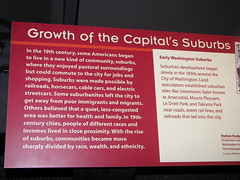
Growth of the Capital's Suburbs, interpretation board, American on the Move exhibit, Smithsonian Museum of American History
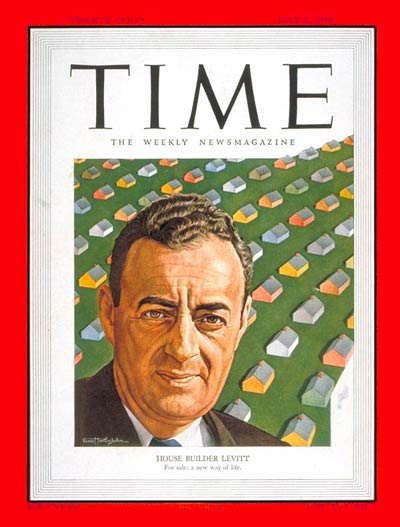
5. And too often this includes elected and high-level appointed officials.
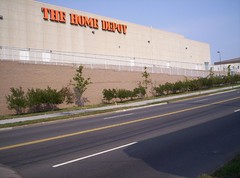
The Brentwood Shopping Center, now called Rhode Island Place, in northeast DC is a perfect example of plopping a suburban design paradigm into the heart of the city. This opportunity should have been seized to repattern this area into a more urban feel, utilizing the air for housing and other mixed uses, leveraging the location immediately adjacent to a subway station. This was done by city officials, who were either unaware or unwilling to push urban design principles on this site and on the developer.

I disagree with Kennicott's assertion that DC needs "cutting edge architecture" to be a city. It needs to recognize and revere what it has, which unlike most cities in North America other than Montreal, is a European feel, with vibrant neighborhoods, density, and an incredible transit system. This is our competitive advantage, that which makes DC unique vis-a-vis almost every other city in the United States, and an advantage that should be strengthened at every opportunity, not diminished.
To recap, for about 5 years, I have testified about what I see as DC's competitive advantages:
1. historic architecture
2. a walking city-based urban design
3. history and authenticity
4. a transit system that allows for non-automobility in the core of the city
5. the steady employment engine of the federal government (cf. Pittsburgh, Newark, Baltimore)
This was complemented by the neighborhood-based historic preservation movement, which worked to preserve DC's great neighborhoods during the many decades in which people didn't want to live in the city.
Note that Cameron Logan, a PhD student at GWU, is writing a fascinating dissertation on what he calls "The Constituent City," based on a report by the National Capital Planning Commission, published in 1950, which for the first time recognized that it was important to plan for the people who lived in the City of Washington, not just around the federal presence. (Lindsay Silver is also writing her dissertation on Capitol Hill and the neighborhood-based organizing there, the rise of the Capitol Hill Restoration Society, fighting freeways and federal government expansion, etc.)
The flipside of the strong neighborhood-based movements was a failure for advocates to focus on city-wide issues, and issues in areas where there were no or few residents, such as downtown, and in areas that lacked the capacity for significant organizing. Of course, one exception to this was the cross-city and multiracial anti-freeway coalition, the Emergency Committee for the Transportation Crisis, which successfully fought off the destruction of the city by freeways--various plans called for a couple of beltways within the city, such as through Dupont Circle, and I-95 along the northeast corridor railroad tracks.
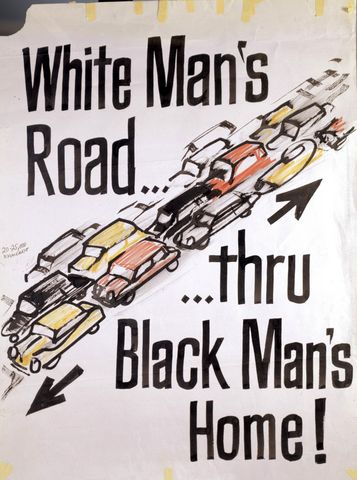
This poster, drawn by Sammie Abbott, was displayed at a demonstration protesting the building of a highway through Washington, D.C. African-American neighborhoods. Artifact. Hand painted sign on paper. Date Made: about 1968. Dates Used: 1968 - 1973. D.C. Community Archives, ECTC Collection, Washingtoniana Division, D.C. Public Library
A few years ago, I toyed with the idea of creating a "Jane Jacobs" urban design reading group, never managing to pull it off (I need others to help, I have too much going on). I got a response from someone who argued that unlike NYC, by comparison DC is an "immature" city. The reality is that DC, especially downtown, had all the same characteristics of a traditional city, the kinds described by Cy Paumier in Creating a Vibrant City Center, where the pattern of downtowns (central business districts) as comprised of pedestrian-scaled streets, blocks, and buildings came about because of:
Concentration and Intensity of Use: "The intensity of development in the traditional central area was relatively high due to the value of the land. Maximizing site coverage meant building close to the street, which created a strong sense of spatial enclosure. Although city center development was dense, construction practices limited building height and preserved a human scale. The consistency in building height and massing reinforced the pedestrian scale of streets, as well as the city center's architectural harmony and visual coherence." (p. 11)
Organizing Structure: "A grid street system, involving the simplest approach to surveying, subdividing, and selling land, created a well-defined, organized, and understandable spatial structure for the cities' architecture and overall development. Because the street provided the main access to the consumer market, competition for street frontage was keen. Development parcels were normally much deeper than they were wide, creating a pattern of relatively narrow building fronts that provided variety and articulation in each block and continuous activity on the street." (p. 12)
The street grid, transportation practices and construction technology of the times, and the cost and value of the land led to a particular form of development on city blocks that focused attention on the streets and sidewalks, creating a human-scaled, architecturally harmonious built environment.
As construction technology advanced and taller buildings could be constructed, and as the walking and transit city was supplanted by the automobile, the scale of block development changed significantly, with a focus away from the pedestrian and towards the car.

Waffle Shop Downtown. Horydczak photo, Library of Congress.

Current photo of the Waffle Shop by Otavio DC.
But it got destroyed for the most part by developers like Oliver Carr, who rebuilt downtown into a bunch of superbuildings, destroying the context, destroying life on the street. Now, Waffle Shop is one of the only businesses left downtown that harkens back to the pre-1980s reconstruction of Downtown. (See chapter four of the book Dream City to understand what happened.)
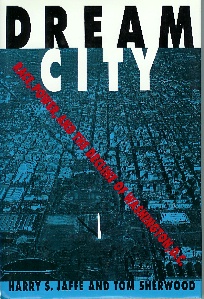
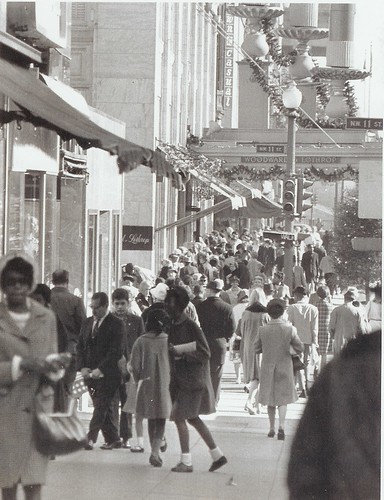
11th and F Streets NW, Washington, DC, December 1968. Washington Star photo.
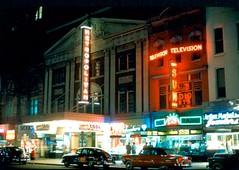
Metropolitan Theater on F Street NW in the 1950s. Photo from Reston Paths.
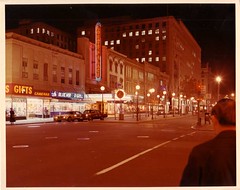
F Street, NW, at 13th Street looking west, with "F Street Plaza," DDOT historical photo.
Here are some suggestions for reading about Washington and its history so you don't sound like a fool:
• Washington in Maps: 1606-2000 by Iris Miller
• Washington on View: The Nation's Capital since 1790 by John Reps
• Washington Through Two Centuries by Joseph Passonneau
• Washington Then and Now by Peter Penczer (where you start to see some of the old photos of the city)
• Washington at Home by Kathy Smith (about neighborhoods in the city)
• context statements for historic districts and thematic surveys (such as for transportation or warehouses) and the printed brochures for historic districts produced by the Historic Preservation Office
• even fiction by George Pelecanos, which describes here and there DC's old ethnic neighborhoods
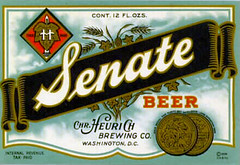
• the various books produced by Arcadia Publishing about DC are interesting (although for many the image research is a bit circumscribed)
• the journal Washington History published by the Historical Society of Washington, and the predecessor publication, Records of the Columbia Historical Society

Labels: cultural heritage/tourism, historic preservation, planning, transportation planning, Washington history



0 Comments:
Post a Comment
<< Home